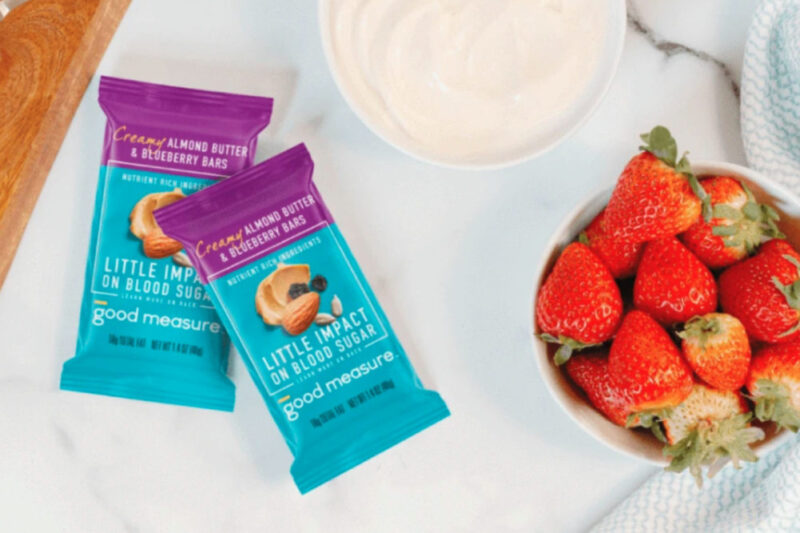To understand more about General Mills’ push into this new space, we talked to the Good Measure team—Kevin Miller (principal scientist at General Mills), Hanna Estrem (associate manager, brand experience at Good Measure), Emily Matthews (omnichannel growth manager at Good Measure), and Brittany Schou (general manager and co-founder of Good Measure)—about breaking into the blood-sugar friendly market, making a blood-sugar friendly snack for a mass audience, and how they chose the ingredients in their products. The following is a condensed version of that conversation.
Of all the niches that General Mills could enter, were there particular trends or data points that led to a product targeting blood sugar?
Good Measure: We’re always thinking of what the big trends are going to be. One that stands out when we assess the Center for Disease Control and Prevention report is that 130 million people in the US–or 39 percent of the population–live with prediabetes or diabetes. There’s such a large segment of the population who are interested in their blood glucose, which is a huge opportunity for our co-founder team to develop a more nutritious snack that is both affordable and convenient.
Ultimately, Good Measure is responding to what we see as a gap in the market by delighting a growing consumer segment with enjoyable yet blood sugar-friendly snacks.
What market are you going after with Good Measure products?
Good Measure: We focus on making food for anybody who cares about blood sugar, whether through a diagnosis or a personal choice. We also know that Good Measure is a generally smart choice for people looking for snacks made with quality ingredients, even if they’re not first and foremost concerned with blood sugar.
We’re also the first in this blood-sugar-conscious space within the consumer-packaged goods world, so we’re still learning about our market.
How did you decide to start with a bar as Good Measure’s first product?
Good Measure: Bars are a really big opportunity. Most people consume a bar at some point in their week. It’s also something that we knew we had the capabilities to develop, too. Our first step wasn’t recreating the wheel.
Before we went to market with Good Measure Nut Butter Bars, we did extensive consumer research to learn about the consumer’s pain points and joys and what they need. Looking at the nutrition bars today, we know that they are not serving blood-sugar-mindful consumers. After identifying that as a primary consumer need, we thought it would be an amazing place to start.
You also recently launched Crisps. Why go there next?
Good Measure: Our research told us that snacking and breakfast were the two most challenging parts of people’s day. We have sweet snackers and savory snackers. Last November, we launched our Good Measure Almond Crisp, which is a savory almond cracker. As you look at the savory snacking space, there are few choices, if any, that are blood sugar-friendly.
Whether our consumers have a diagnosis or are following a diet, it would be a bonus if they had help with their cravings. But we have to go back to our design principles to use nutrient-dense ingredients that also offer good taste.
As you were formulating your bar, how did you make something that would appeal to a broad audience? And how did you think about trade-offs you’d have to make to develop a blood-sugar-friendly bar?
Good Measure: We had three driving design principles: blood sugar-friendly, nutrient-dense ingredients, and tasty. It’s hard to do those three things well. When you eat Good Measure’s snacks, we want you to see the list of real ingredients and take comfort that it’s food that tastes good. We also want to assist with blood sugar impact. That’s why we may not be producing three new products a year. We want to take our time and get it right. If that slows down category expansion, that’s a trade-off that we’ll make.
As part of General Mills’ G-Works studio, we also have capabilities that other smaller organizations don’t. We have in-house flavor scientists who can help us ensure that these products have the right taste and aroma. For example, there are multiple types of sweeteners, both caloric and non-caloric, out there. Whether or not they will crystallize and give you the right mouth texture and aftertaste are all critical.
What were some particular challenges you encountered when developing the products?
Good Measure: If you eat our bars, you’ll realize they have a unique creamy texture. We purposely chose not to include certain binders, such as a high fructose corn syrup, because those just aren’t blood sugar friendly. Then you’re challenged with will the bar hold up? If it gets tossed into a gym bag or a purse, will it crumble in the package? That’s one of the trade-offs when you use ingredients like this. We discovered that if you store our product in the fridge or even in the freezer, it tightens up and doesn’t crumble as easily. It also offers an entirely different eating experience.
Can you talk about the decision to use certain oils–palm kernel, sunflower, and canola oil, in particular–in your bars and crisps?
Good Measure: These were chosen to meet the overall product profile, nutrition profile, and what would be the most functional to deliver the best hedonics associated with the product. As for lipids, there are several you can choose from. You have the very long chain fatty acids, such as in fish oils, and the shorter chain fatty acids that you’d find in plants and nuts. Your omega-6s can be more pro-inflammatory, but they still have an important role in maintaining cell integrity in the body. Even saturated fats can play a role as well. You need to look at a blend of lipids coming in through the diet, which can come in through individual products.
Right now, there’s canola oil in it. We’ve heard from folks in our community that we should revisit this, and we’re working with nutritionists and dietitians to reformulate it this year.
You use allulose in your products. How did you land on allulose as the sweetener?
Good Measure: When selecting allulose, we looked at the main design principles we mentioned. Is allulose blood sugar friendly? Does it taste good? Yes, to both. We know that allulose is scientifically demonstrated to have little impact on blood sugar. It also had to taste good, and we know that allulose looks and tastes like table sugar. From our research, we knew that our customers wanted to enjoy food again while making choices that suited their lifestyle, and allulose didn’t have this bitter aftertaste as some other non-nutritive sweeteners.
For those on the Good Measure Team who wore Levels, what are some of your favorite metabolically healthy meals?
Hanna: Blood sugar has been a big part of my life by proxy. My sister was diagnosed with Type 1 at age five, so it’s been in my ecosystem. I’ve thought about it a lot. I never go wrong with smoothies. If I have the right ratio of fat, protein, fiber, and carbs, I get a very stable glucose response. My go-to is peanut butter, yogurt, chocolate protein powder, spinach, and blueberries. I will have that for either breakfast, lunch, or dinner.
Brittany Schou: I was happy that my breakfast of Greek yogurt, blueberries, and almonds was great. I’ll do a low-glycemic wrap with turkey, avocado, greens, and tomato for lunch. My new favorite is Good Measure Almond Crisps dipped in cottage cheese for a snack.
Emily: I would say taco bowls are one of our household favorites. I love it because my husband and I can customize it to what we want on it. I do tons of veggies, taco meat, guac, some cheese, and sour cream. If you think back to even 15 years ago, I’d think I don’t need the extra calories with cheese and sour cream. But now, I think of them as part of a balanced meal.









